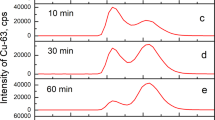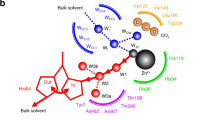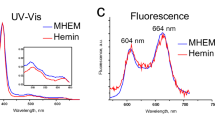Abstract
IT was shown by Henriques1 that the rate at which carbon dioxide is evolved in the reaction H2CO3⇌ CO2 + H2O is greatly accelerated by the presence of laked blood, mere traces of which are sufficient to catalyse this reaction4. That this acceleration is not due to hæmoglobin was clearly demonstrated by Meldrum and Roughton3,4 who have separated from the red blood corpuscles a now enzyme capable of catalysing both phases of the above reaction. They described this enzyme under the name of carbonic anhydrase and gave a detailed account of its properties. Their purified preparation of this enzyme was a colourless substance, very active and sensitive to KCN, H2S and NaN3. The amount of this enzyme-preparation was, however, very small and scarcely sufficient even to recognize it with certainty as a protein compound. In the course of our study of metallo-protein compounds5 present in the red blood corpuscles, we have found that the fractions of our preparations left after the complete removal of hæmocuprein had a very high content of zinc and a high carbonic anhydrase activity. By adapting our methods of purification to preparations on larger scale, such as 10 litres of blood at a time, and taking special care to increase the yield of the zinc fraction, we have obtained a highly active preparation of carbonic anhydrase. The activities of different fractions have been tested both by the manometric ‘boat’ method3 and the colorimetric method6. The zinc in different fractions was determined by the dithizone and by the iodometric ferricyanide methods and was also isolated as a crystalline zinc quinaldinat salt.
This is a preview of subscription content, access via your institution
Access options
Subscribe to this journal
Receive 51 print issues and online access
$199.00 per year
only $3.90 per issue
Buy this article
- Purchase on Springer Link
- Instant access to full article PDF
Prices may be subject to local taxes which are calculated during checkout
Similar content being viewed by others
References
Henriques, O., Biochem. Z., 200, 1 (1928).
Brinkman, R., and Margaria, E., J. Physiol., 72, 6P (1931).
Meldrum, N. U., and Roughton, F., J. Physiol., 80, 113 and 143 (1931).
Mann, T., and Keilin, D., Proc. Roy Soc., B, 126, 303 (1938).
Philpot, F., and Philpot, J., Biochem. J., 30, 2191 (1936).
Author information
Authors and Affiliations
Rights and permissions
About this article
Cite this article
KEILIN, D., MANN, T. Carbonic Anhydrase. Nature 144, 442–443 (1939). https://doi.org/10.1038/144442b0
Issue Date:
DOI: https://doi.org/10.1038/144442b0
This article is cited by
-
Zinc supplementation modifies brain tissue transcriptome of Apis mellifera honeybees
BMC Genomics (2022)
-
The emerging role of zinc transporters in cellular homeostasis and cancer
Signal Transduction and Targeted Therapy (2017)
Comments
By submitting a comment you agree to abide by our Terms and Community Guidelines. If you find something abusive or that does not comply with our terms or guidelines please flag it as inappropriate.



